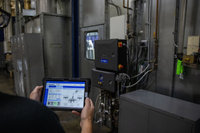How to Choose the Right Paint Mixing Machine
Using electronic proportioning systems can save time and money. But how do you choose the right machine?
Using electronic proportioning system for accurate mixing and metering can save time and money, but how do you choose the right machine? And how much do good proportioners cost?
A lot of factors go into choosing a proportioner that fits your unique needs. Depending on your requirements, systems can cost anywhere from $10,000 to $50,000.
Whether you’re new to electronic proportioning, or looking to expand, there are many choices to fit your needs and budget.
Top 3 Considerations for Paint Mixing and Metering Equipment
Be sure to consider these three areas when buying plural component equipment.
1. Material Chemistry
Because the chemistry of every material varies, it is important to keep in mind the kind of coating are you managing. This will affect what meter to use, as well as the type of flushing and dosing that will be required.
The more difficult the material, the more important it is to invest in higher performing meters and flushing accessories. If you want to prime and top coat in the same booth, you will need to keep epoxy and urethane materials separate.
Some systems, like the ProMix PD2K, will allow you to manage both epoxy and urethane in one unit. Otherwise, a single color entry level system will manage the epoxy primer while a multi color system manages the top coat urethane. This requires careful balancing of cost, space available and system architecture.
2. Current Color Use and Color Expansion
Managing the number of colors needed now is key, but don’t forget expansion. You may think you need an entry-level system, but in another year or two, this could change. Be sure to select a system that can grow with you to get the most out of your investment.
If you choose an entry level system, be aware that many do not have the ability to expand. Systems like the ProMix 2KS and ProMix PD2K initially may be more expensive. But they can expand to add colors and catalysts with a much smaller secondary investment than if you were to purchase an entirely new system.
3. Metering and Flushing Components
These are also important to making the right proportioning choice. If you don’t get this right, you could end up spending time and money to maintain components that clog or cause measurement problems.
- Mixing epoxy and urethane materials can lead to frequent maintenance problems.
- Waterborne materials require water and solvent to flush properly.
- Some materials are sheer sensitive, which may not allow a gear meter to be used.
All of the above should be considered carefully when selecting a proportioning system.
Free Webinar
Plural Component Mixing: How to Calculate ROI
This 30-minute, on-demand webinar covers how to calculate the return on investment (ROI) for plural component mixing equipment.
Related Articles
Maintain Ratio Accuracy and Reduce Waste
Electronic proportioners have become popular in finishing operations because of their ability to maintain ratio accuracy and reduce waste.
How to Calculate Total Cost of Ownership
When looking at the total cost of ownership, be sure to calculate energy costs, maintenance, and repair fees








